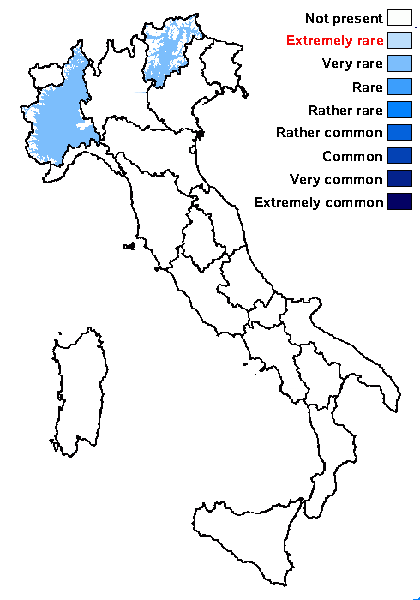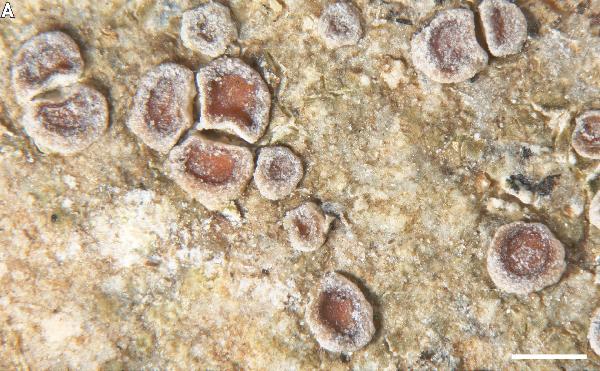Sarcogyne distans (Arnold) K. Knudsen & Kocourk.
in Knudsen & al., Herzogia, 37, 1: 11, 2024. Basionym: Acarospora glaucocarpa f. distans Arnold - Ber. bayer. bot. Ges., 1, Anh.: 49, 1891.
Synonyms:
Distribution: N - TAA, Piem (Baglietto e Carestia 1880).
Description: Thallus crustose, mostly endosubstratic and inapparent, sometimes with scattered algae at the base of apothecia, 200-300(-400) μm thick, containing substrate crystals, the hyphae vertically oriented to intricate, c. 2 μm thick, the outer surface brown and corticate below the apothecial margins. Apothecia usually dispersed, rarely clustered in small groups, broadly attached, 0.2-1 mm across, 0.3-0.5(-0.6) μm high, emerging from a medullary base, the disc pale or dull brown, reddish-brown or yellow-orange when dry, reddish brown to red or orange when wet, lower than or even with margin, rarely convex, usually epruinose unless the margin is heavily pruinose; proper margin brown, pruinose or epruinose. Proper exciple expanding around the disc, 50-100 μm wide, IKI- but sometimes the IKI+ blue hymenial gel bleeding into it; epithecium brownish, <10 μm high; hymenium colourless, 70-100 μm high, the hymenial gel IKI+ dark blue, euamyloid; paraphyses 1-2 μm thick, the apical cells unexpanded, sometimes with a c. 3 μm wide gel cap with black pigment; subhymenium 20-30(-50) μm high, IKI+ dark blue, euamyloid; hypothecium colourless, 20-30 μm high, continuous with the proper exciple, subtended by a thin to continuous algal layer not extending into margins. Asci multispored, clavate, the apical dome K/I-, 60-80 x 15-17 μm. Ascospores 1-celled, hyaline, ellipsoid, 4-5 x 1-2 μm. Photobiont chlorococcoid. Spot tests: thallus K-, P-, KC-, P-. Chemistry: without lichen substances. Note: a segregate from the very polymorphic aggregate of ”Acarospora” glaucocarpa, growing on calcareous and ultrabasic siliceous rocks (see Knudsen & al. 2024). The specimen from South Tyrol was collected by Arnold between Schluderbach/Carbonin and Fondo (Knudsen, in litt.).
Growth form: Crustose endolithic
Substrata: rocks
Photobiont: green algae other than Trentepohlia
Reproductive strategy: mainly sexual
Commonnes-rarity: (info)
Alpine belt: absent
Subalpine belt: absent
Oromediterranean belt: absent
Montane belt: very rare
Submediterranean belt: very rare
Padanian area: absent
Humid submediterranean belt: absent
Humid mediterranean belt: absent
Dry mediterranean belt: absent

Predictive model

Courtesy K. Knudsen. Source: Knudsen, K., Kocourková, J., Peksa, O., Beck, A., Velmala, S. & Wirth, V. 2024 Three poorly known Acarosporaceae of Central Europe: new reports from Czech Republic, Germany, and Italy. – Herzogia 37: 5 –15.
A – Pruinose apothecia broadly attached to substrate, replicating by division, coll. F. Arnold
(M-0190200, lectotype). B – Groups of non-pruinose apothecia, coll. F. Bouda (PRM 860116). Scale A, B=500 μm.

Courtesy K. Knudsen. Source: Knudsen, K., Kocourková, J., Peksa, O., Beck, A., Velmala, S. & Wirth, V. 2024 Three poorly known Acarosporaceae of Central Europe: new reports from Czech Republic, Germany, and Italy. – Herzogia 37: 5 –15.
A – Pruinose apothecia broadly attached to substrate, replicating by division, coll. F. Arnold
(M-0190200, lectotype). B – Groups of non-pruinose apothecia, coll. F. Bouda (PRM 860116). Scale A, B=500 μm.
Growth form: Crustose endolithic
Substrata: rocks
Photobiont: green algae other than Trentepohlia
Reproductive strategy: mainly sexual
Commonnes-rarity: (info)
Alpine belt: absent
Subalpine belt: absent
Oromediterranean belt: absent
Montane belt: very rare
Submediterranean belt: very rare
Padanian area: absent
Humid submediterranean belt: absent
Humid mediterranean belt: absent
Dry mediterranean belt: absent

Predictive model

Courtesy K. Knudsen. Source: Knudsen, K., Kocourková, J., Peksa, O., Beck, A., Velmala, S. & Wirth, V. 2024 Three poorly known Acarosporaceae of Central Europe: new reports from Czech Republic, Germany, and Italy. – Herzogia 37: 5 –15.
A – Pruinose apothecia broadly attached to substrate, replicating by division, coll. F. Arnold (M-0190200, lectotype). B – Groups of non-pruinose apothecia, coll. F. Bouda (PRM 860116). Scale A, B=500 μm.

 DOLICHENS
DOLICHENS

